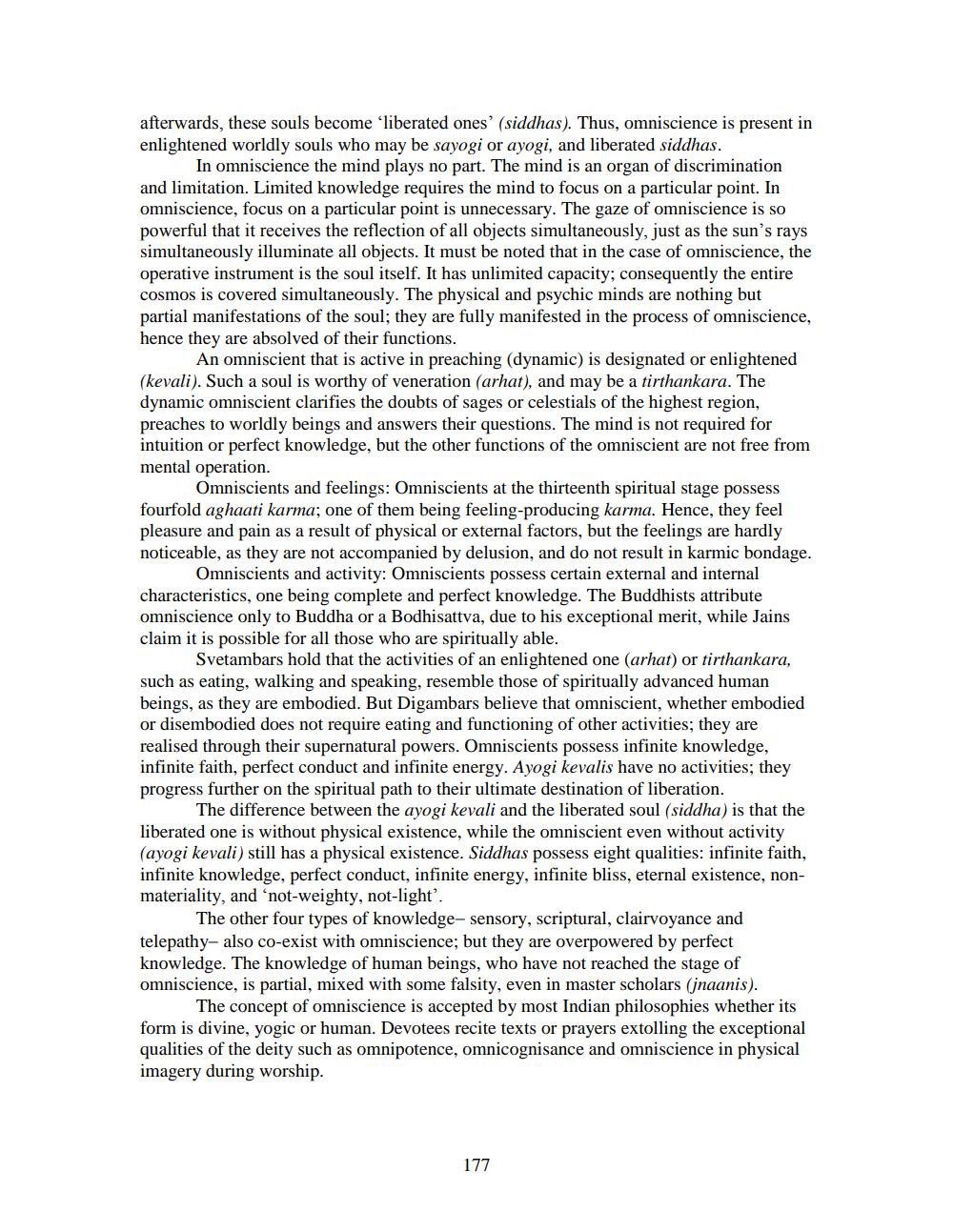________________
afterwards, these souls become “liberated ones' (siddhas). Thus, omniscience is present in enlightened worldly souls who may be sayogi or ayogi, and liberated siddhas.
In omniscience the mind plays no part. The mind is an organ of discrimination and limitation. Limited knowledge requires the mind to focus on a particular point. In omniscience, focus on a particular point is unnecessary. The gaze of omniscience is so powerful that it receives the reflection of all objects simultaneously, just as the sun's rays simultaneously illuminate all objects. It must be noted that in the case of omniscience, the operative instrument is the soul itself. It has unlimited capacity; consequently the entire cosmos is covered simultaneously. The physical and psychic minds are nothing but partial manifestations of the soul; they are fully manifested in the process of omniscience, hence they are absolved of their functions.
An omniscient that is active in preaching (dynamic) is designated or enlightened (kevali). Such a soul is worthy of veneration (arhat), and may be a tirthankara. The dynamic omniscient clarifies the doubts of sages or celestials of the highest region, preaches to worldly beings and answers their questions. The mind is not required for intuition or perfect knowledge, but the other functions of the omniscient are not free from mental operation.
Omniscients and feelings: Omniscients at the thirteenth spiritual stage possess fourfold aghaati karma; one of them being feeling-producing karma. Hence, they feel pleasure and pain as a result of physical or external factors, but the feelings are hardly noticeable, as they are not accompanied by delusion, and do not result in karmic bondage.
Omniscients and activity: Omniscients possess certain external and internal characteristics, one being complete and perfect knowledge. The Buddhists attribute omniscience only to Buddha or a Bodhisattva, due to his exceptional merit, while Jains claim it is possible for all those who are spiritually able.
Svetambars hold that the activities of an enlightened one (arhat) or tirthankara, such as eating, walking and speaking, resemble those of spiritually advanced human beings, as they are embodied. But Digambars believe that omniscient, whether embodied or disembodied does not require eating and functioning of other activities, they are realised through their supernatural powers. Omniscients possess infinite knowledge, infinite faith, perfect conduct and infinite energy. Ayogi kevalis have no activities, they progress further on the spiritual path to their ultimate destination of liberation.
The difference between the ayogi kevali and the liberated soul (siddha) is that the liberated one is without physical existence, while the omniscient even without activity (ayogi kevali) still has a physical existence. Siddhas possess eight qualities: infinite faith, infinite knowledge, perfect conduct, infinite energy, infinite bliss, eternal existence, nonmateriality, and 'not-weighty, not-light'.
The other four types of knowledge-sensory, scriptural, clairvoyance and telepathy, also co-exist with omniscience; but they are overpowered by perfect knowledge. The knowledge of human beings, who have not reached the stage of omniscience, is partial, mixed with some falsity, even in master scholars (inaanis).
The concept of omniscience is accepted by most Indian philosophies whether its form is divine, yogic or human. Devotees recite texts or prayers extolling the exceptional qualities of the deity such as omnipotence, omnicognisance and omniscience in physical imagery during worship.
177




